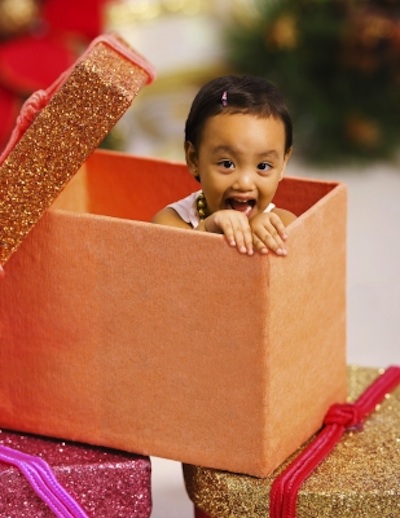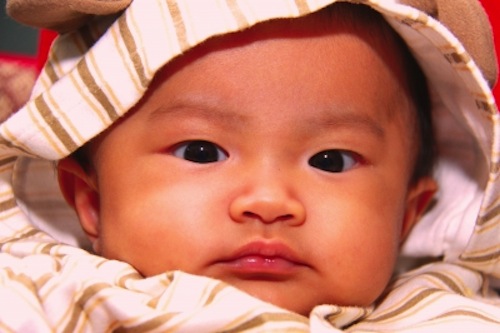5 Everyday Objects that Your Baby Will Love to Play With
Sometimes we get so caught up with the cool, new technological baby toys that we forget how much fun they can have with simple, everyday objects. Babies’ curiosity makes simple items lying around the house new adventures. Here are a few to explore with your little one:
Scarves
That pile of scarves sitting in your closet is more than just a bunch of accessories. It’s a great way to make your little one smile. Not only do babies love the silky texture of scarves, but the colorful, bright patterns are sure to catch their eye. Try throwing them around so your baby can watch them twirl around in the air.
Pots and Pans
Just like in the movies, babies love the sound of banging on some pots and pans. Grab a spoon or spatula, some pots or pans and let your little one rock out. OK, so we know the noise can be enough to cause a migraine, so just make sure that you set aside a short time period and stick to it.
Plastic Cups
Safe and simple- babies love stacking plastic cups. Grab a variety of sizes and colors and set them out in front of your little one. The best part? They make for a fast cleanup!
Tupperware
Grab some Tupperware with lids and show your baby how to snap them on. They’ll have a blast matching up the right ones.
Cardboard Boxes
Grab some big cardboard boxes and make a tunnel for your baby to crawl around in. Let them hide under them and cruise through them.
Sources:
-“11 Fun Activities for When Winter Weather Traps You Indoors.” Parents.com
-“5 Unexpected Household Items that Babies Love to Play With.” Yahoo Shine
-Photo courtesy of Stuart Miles/freedigitalphotos.net
Diaper Bag Checklist
With closets full of diapers, bottles stuffed in your cupboards and toys cluttering your countertops, it’s tough to know exactly what you should have in your diaper bag. You hear phrases about how moms always need to be prepared, but how can you possibly stuff all of that gear into one little (ok, maybe it’s closer to the size of a minivan than you’d like to admit) bag? Here’s a simple checklist to help you organize and prioritize what goes into your diaper bag:
Essentials
The essentials are items that you probably want to have on you at all times, regardless of where you’re going and for how long.
-Diapers (always at least one more than you think you need)
-Wipes (Tip: Save by buying in bulk and sticking them in ziplock bags “travel” bags)
-Plastic bags
-A changing pad
-Bottles and formula
-Snacks (toddlers)
-Sippy cup (toddlers)
-Backup outfit
-Blanket
-Sunscreen
-Pacifier (maybe throw in an extra one since little nooks tend to go missing often)
-Emergency info (better yet, store important information, like doctor’s phone numbers, in your cell phone)
-Favorite toy
-Diaper rash cream
-Bib
Extras
If you have extra space (haha) or plan on being away for a full day or more, consider taking a few more items.
-Extra clothing (and really extra of everything in the essential list)
-Pain relievers
-Comfort toy for your little one to nap with
-Hat if you’re going to be out in the sun
-Hat, mittens and other winter gear if it’s chilly out
-Nail clippers
-Camera
-First-aid kit
Sources:
-“Checklist: What to Put in Your Diaper Bag.” Baby Center
-“What to Keep in Your Baby Diaper Bag.” Parents.com
-“Diaper Bag Essentials.” Mom Advice
-Photo courtesy of digitalart/freedigitalphotos.net
New Study Shows Pacifiers May Stunt Emotional Growth in Boys
Researchers at the University of Wisconsin, Madison found that pacifiers might stunt emotional development, but only in boys. Psychologists at Wisconsin led three experiments connected low emotional maturity to heavy pacifier use as a child.
Psychologists believe the nookies may make it difficult to imitate adult’s facial expressions, a skill that children are perfecting at the binky age. The theory held true for both the six and seven-year-olds and college-aged males that the researchers studied.
The six and seven-year-olds were measured by the amount they mimicked expressions on a video and college males took perspective taking tests. Both experiments were meant to mimic empathy. And in both cases, those who reported heavy pacifier use as children scored lower.
Girls, however, showed no direct correlations between emotional maturity and pacifier use as a child. It may be due to the fact that girls tend to develop earlier, but the reason remains a mystery.
This problem only occurs when facial expressions are being utilized. During times like nap and bedtimes, children are sleeping so expression mimicking is not happening. So even though it may be wise to wean boys off of binkies, this doesn’t mean that parents of baby boys should ditch pacifiers completely.
Sources:
-University of Wisconsin, Madison news releases. 9/18/12.
-Photo courtesy of Carlos Porto/freedigitalphotos.net
Sign Language for Babies
Recently, more and more parents have been teaching their little ones sign language, many before they can even speak. The idea is that babies have the cognitive ability to comprehend language, but lack the physical ability to make the sounds. They can, however, learn sign language because the ability to make hand motions comes before the ability to easily form words.
Many experts even believe the benefits of learning sign language go farther than communication. Some have found that use of signing as a baby leads to confidence and higher self-esteem later in life. Signing also rewards eye contact, an important component of socializing that they’ll master in their later years.
Take the time for a short class, research online or pick up a book on simple sign language. Then start signing to your baby when you speak to him or her. As early or six or seven months, little ones can start using those signs to communicate with you.
Manners
“Please” and “thank you” are easy signs to learn, but they’ll help instill manners from the very beginning, making them a habit and giving you the most polite baby around!
Food
Teach your baby his or her favorite foods. Signs for “milk” “peas” and “applesauce” could save you a spit up mouthful of mushed up carrots. Plus, the simple signs for “food” and “water” help your baby tell you when he or she is hungry or thirsty.
Useful words
Signs for “more” and “done” can be more useful than imaginable. Babies often throw tantrums to show frustration and what’s more frustrating than being unable to communicate? Save yourself a scene by teaching your little one how to ask for more or tell you they’re finished.
Sources:
-“Baby sign language: top ten starter signs.” Baby Sign Language
-“Teaching your baby sign language can benefit both of you.” Psych Central
-Photo courtesy of photostock/freedigitalphotos.net
Mommy Math: Most Popular Baby Names
For over five years, Aiden has reigned as the most used boy name and Sophia has made the top five. At MomTrusted, we mapped out the five most popular names for boys and girls, using a star system. Each year, the most popular received five stars and the fifth most popular received one star.
20 Fun Baby Facts
1. Some babies can start to recognize a mother’s voice at as early as two days old.
2. Four out of 10 babies have at least one birthmark when they’re born.
3. We have 206 bones, but babies are born with 300 because many fuse together as they grow.
4. Crying helps calm babies down because tears release a stress hormone. However, it takes between three weeks and five months for babies to actually develop tears when crying.
5. Babies quickly lose any hair that they’re born with.
6. Smiling isn’t just copying, but rather something that comes naturally to babies. The fact that blind babies smile proves it!
7. The most popular day for childbirth in the U.S. is Tuesday.
8. A newborn’s heart beats about twice as fast as an adult’s.
9. All babies are born prematurely and some doctors refer to their first few months of life as the fourth trimester.
10. Over four million babies are born each year in the U.S.
11. Newborns have poor eyesight and can only focus on objects about eight inches away. They are not, however, colorblind, contrary to popular belief.
12. Baby tummies are tiny. An eight-pound baby can only drink about three ounces of milk at a time.
13. A baby is born somewhere in the world every three to five seconds.
14. Newborns don’t sweat. Their sweat glands have yet to fully develop.
15. Almost all babies are born with blue eyes and a pug nose.
16. Babies’ sense of smell is much stronger than adults’. They use this to get to know their mothers early on.
17. After only a few days, mothers can distinguish their children’s cries from those of other babies.
18. Babies are born without kneecaps.
19. Infants learn emotions by imitating adults’ expressions.
20. Baby brains double in size during the first year.
Sources:
-“Surprising facts about birth in the United States.” Baby Center.
-“21 fascinating facts about your baby.” Bounty.com.
-“25 facts you should know about a newborn baby.” Milliontalks.com
-“Fun Baby Facts.” Kinderpods.
-Nixon, Robin. “11 Facts Every Parent Should Know About Their Baby’s Brain.” Live Science.
-Photo courtesy of koratmember/freedigitalphotos.net

















